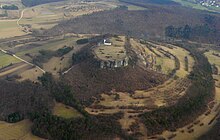
The La Tène culture was a European Iron Age culture. It developed and flourished during the late Iron Age, succeeding the early Iron Age Hallstatt culture without any definite cultural break, under considerable Mediterranean influence from the Greeks in pre-Roman Gaul, the Etruscans, and the Golasecca culture, but whose artistic style nevertheless did not depend on those Mediterranean influences.

Ambrussum is a Roman archaeological site in Villetelle, Occitania, Southern France.
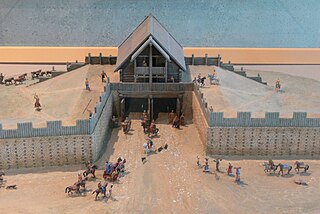
An oppidum is a large fortified Iron Age settlement or town. Oppida are primarily associated with the Celtic late La Tène culture, emerging during the 2nd and 1st centuries BC, spread across Europe, stretching from Britain and Iberia in the west to the edge of the Hungarian plain in the east. These settlements continued to be used until the Romans conquered Southern and Western Europe. Many subsequently became Roman-era towns and cities, whilst others were abandoned. In regions north of the rivers Danube and Rhine, such as most of Germania, where the populations remained independent from Rome, oppida continued to be used into the 1st century AD.
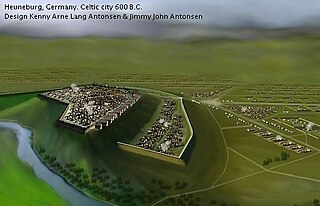
The Heuneburg is a prehistoric Celtic hillfort by the river Danube in Hundersingen near Herbertingen, between Ulm and Sigmaringen, Baden-Württemberg, in the south of Germany, close to the modern borders with Switzerland and Austria. It is considered to be one of the most important early Celtic centres in Central Europe, particularly during the Iron Age Hallstatt culture period. Apart from the fortified citadel, there are extensive remains of settlements and burial areas spanning several centuries.

The Remi were a Belgic tribe dwelling in the Aisne, Vesle and Suippe river valleys during the Iron Age and the Roman period. Their territory roughly corresponded the modern Marne and Ardennes and parts of the Aisne and Meuse departments.

The Suessiones were a Belgic tribe, dwelling in the modern Aisne and Oise regions during the La Tène and Roman periods.

Oldbury Camp is the largest Iron Age hill fort in south-eastern England. It was built in the 1st century BC by Celtic British tribes on a hilltop west of Ightham, Kent, in a strategic location overlooking routes through the Kentish Weald. The fort comprises a bank and ditch enclosing an area of about 50 hectares, with entrances at the north-east and south ends. Wooden gates barred the entrances. Archaeological excavations carried out in the 1930s and 1980s found that the hill fort's interior had probably not been permanently occupied. It had been abandoned around 50 BC and the north-east gate had been burned down, possibly due to a Roman invasion. The wooded southern part of Oldbury Camp is now owned and managed by the National Trust and is open to the public.

Vaison-la-Romaine is a town in the Vaucluse department in the Provence-Alpes-Côte d'Azur region in southeastern France.

The Oppidum of Manching was a large Celtic proto-urban or city-like settlement at modern-day Manching, near Ingolstadt, in Bavaria, Germany. The Iron Age town was founded in the 3rd century BC and existed until c. 50-30 BC. It reached its largest extent during the late La Tène period, when it had a size of 380 hectares. At that time, 5,000 to 10,000 people lived within its 7.2 km walls. Thus, the Manching oppidum was one of the largest settlements north of the Alps. The ancient name of the site is unknown, but it is assumed that it was the central site of the Celtic Vindelici tribe.
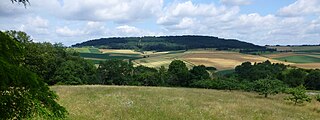
The Glauberg is a Celtic hillfort or oppidum in Hesse, Germany consisting of a fortified settlement and several burial mounds, "a princely seat of the late Hallstatt and early La Tène periods." Archaeological discoveries in the 1990s place the site among the most important early Celtic centres in Europe. It provides unprecedented evidence on Celtic burial, sculpture and monumental architecture.

Alesia was the capital of the Mandubii, one of the Gallic tribes allied with the Aedui. The Celtic oppidum was conquered by Julius Caesar during the Gallic Wars and afterwards became a Gallo-Roman town. Modern understanding of its location was controversial for a long time; however, it is now thought to have been located on Mont-Auxois, near Alise-Sainte-Reine in Burgundy, France.

The Ipf is a mostly treeless mountain, near Bopfingen, Ostalbkreis, Baden-Württemberg, Germany, with a prehistoric hill fort on its top.

The Vix Grave is a burial mound near the village of Vix in northern Burgundy. The broader site is a prehistoric Celtic complex from the Late Hallstatt and Early La Tène periods, consisting of a fortified settlement and several burial mounds.

The Parisii were a Gallic tribe that dwelt on the banks of the river Seine during the Iron Age and the Roman era. They lived on lands now occupied by the modern city of Paris, whose name is derived from the ethnonym.

Titelberg is the site of a large Celtic settlement or oppidum in the extreme south west of Luxembourg. In the 1st century BCE, this thriving community was probably the capital of the Treveri people. The site thus provides telling evidence of urban civilization in the century before the Roman conquest.
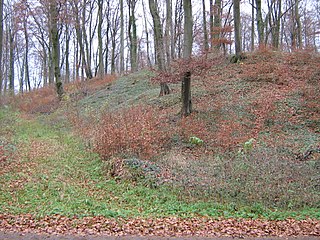
Celtic Luxembourg existed during the period from roughly 600 BC until 100 AD, when the Celts inhabited what is now the territory of the Grand Duchy of Luxembourg. Their culture was well developed, especially from the 1st century BC, as can be seen from the remains of the extensive Titelberg site in the far southwest of the country and from the impressive finds in several tombs and necropolises in the Moselle valley and its surroundings.

Corent is a commune in the Puy-de-Dôme department in Auvergne-Rhône-Alpes in central France.
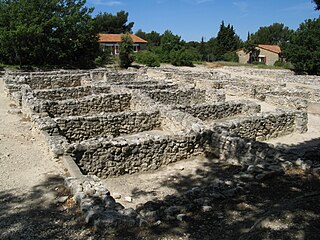
Entremont is a 3.5-hectare (8.6-acre) archaeological site three kilometres from Aix-en-Provence at the extreme south of the Puyricard plateau. In antiquity, the oppidum at Entremont was the capital of the Celtic-Ligurian confederation of Salyes. It was settled between 180 and 170 B.C., somewhat later than the inhabitation of other oppida, such as Saint-Blaise. The site was abandoned when it was taken by the Romans in 123 B.C. and replaced by Aquae Sextiae, a new Roman city founded at the foot of the plateau. By 90 B.C., the former oppidum was completely uninhabited.

Turicum was a Gallo-Roman settlement at the lower end of Lake Zurich, and precursor of the city of Zürich. It was situated within the Roman province of Germania Superior) and near the border to the province of Raetia; there was a tax-collecting point for goods traffic on the waterway Walensee–Obersee-Zürichsee–Limmat–Aare–Rhine.

Heidengraben is the name given to the remains of a large Celtic fortified settlement (oppidum) dating to the Iron Age, located on the plateau of the Swabian Jura in the districts of Reutlingen and Esslingen in Baden-Württemberg, Germany. The settlement was in use from the 2nd century BC to 1st century BC, during the La Tène period. By surface area, Heidengraben is the largest oppidum in all of mainland Europe.
